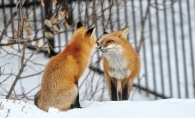“It’s just very rare that there is this door open to having your name out there by winning a contest in an anonymous setting like that.” —Joe Hautman
On any given morning, Joe Hautman steps out to the pond in his Plymouth backyard and sees hundreds of wood ducks. He built a box in a nearby tree to house them. Each season, he watches in amazement as ducklings plummet to the ground below—and survive to waddle on under Mother’s watchful eye.
Hautman draws artistic inspiration from his backyard creatures, as well as from other North American wildlife. Along with his two younger brothers, Jim and Bob, he has been widely recognized for his talent; the trio has seen national and international success.
Unlike his brothers, who set out for careers as artists from the get-go and received some national recognition – each have won more than one Federal Duck Stamp contest and many state duck stamp contests– painting wasn’t Hautman’s plan, let alone passion growing up. Although his mother was an avid artist, he enjoyed science. He graduated from the University of Minnesota in 1979 with a degree in physics, then went on to receive a masters’ degree in physics from the University of Michigan in 1981 and a doctorate there in 1985.
Thus, art was a hobby, whereas science was a career. “I have always liked to do art, it was a natural thing,” Hautman says. “But I liked the sciences also.”
This all changed in 1991, however, “before anyone knew there was another Hautman brother who painted,” Hautman says, when he sold his first painting. Interestingly, that painting earned the Federal Duck Stamp honor—and Hautman met President George H.W. Bush, as the contest rewards artistic prowess and skill on a national level (it’s the only one run by the federal government). Hautman credits the contest for giving him the push into the art world. “It’s just very rare that there is this door open to having your name out there by winning a contest like that,” he says.Hautman resigned from his research position at the University of Pennsylvania soon after. While his mom enjoyed art, his dad found solace in the outdoors, and he followed suit, continuing his interest in painting. “Growing up, I was always interested in wildlife. This, like art, was also a natural thing,” he says.
Artistic expression became a collective family affair. In 2003, Hautman and his brothers dabbled into actual postage stamp design for the first time (the duck stamp contest is based solely on a decorative image). The stamps were an artistic series that highlighted 12 endangered species from around the world; an initiative of the United Nations, it commemorated the anniversary of an international agreement on endangered species. Leaders approached the family and asked if they wanted to do the stamp series. “It was just kind of an interesting application for other kinds of things we do for conservation stamps,” Hautman says.
Throughout, Hautman continued to travel and drew inspiration from foreign land wildlife, including tigers and panda bears. He also went on to win the Federal Duck Stamp contest three more times, which included the 2012–2013 stamp, awarded in 2011. Although Hautman left the world of science professionally, he continues to incorporate physics into his artwork. “It makes me go off on tangents and makes me ask what I am doing,” Hautman says. “It gives me a scientific curiosity of the physics and chemistry of what is going on in nature.”
The Hautman brothers are a strong team. Whether researching, asking for photography tips, embarking on hunting trips or seeking feedback, they believe the brother connection is helpful to making their art the best it can be. “It’s really valuable for someone to come and give a fresh look at things. The nice thing about your brothers is they don’t hold back,” Hautman says.
Architect, avid art connoisseur and a longtime fan of the Hautmans, Jim Dayton approached the brothers in early fall 2013. The brothers hadn’t done a show together for 13 years, so they agreed to showcase an exhibit at the Minnetonka Center for the Arts. Hautman acknowledges that “we were due to get out there and showcase our stuff,” but they usually shy away from shows. “I thought that was a shame. I don’t think a lot of hunters, for example, know about the Hautmans,” Dayton says. “I thought [the art center] was a good match; they needed a show, and people wanted to see their work.”
He describes their paintings as photographic, without a trace of the hand. The Hautman Brothers Wildlife Art Exhibit exhibit was held last October and exceeded expectations. From outdoorsmen to art enthusiasts, it brought out all types of fans, Minnetonka Center for the Arts communications director Sara Skalle says. The center extended the exhibit’s length, and on many days it saw more than 100 visitors. “What I so admire is their eye for detail, not only capturing the critter, not only capturing the animal itself in precise detail, but its environment,” Skalle says. “That’s the beauty of their art for everyone. Everyone can appreciate nature. Their artwork touches us in a very basic place.”
Visit hautman.com to view more completed and in-progress paintings by all three Hautman brothers.
The Minnetonka Center for the Arts showcases art year round.
Check out its current exhibit and classes at minnetonkaarts.org.









